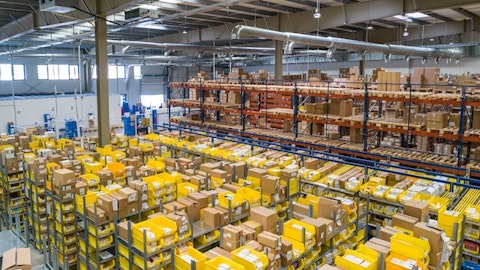Michael Vermut: Can you just walk us through what the margins, what the OR could look like? Let’s say we get to that $750,000 right which is the off of our bases a significant portion of our fleet rate of what we’re running — what two, three years down the road kind of OR I assumes it’s a better OR than the than the overall –
David Parker: Yeah. No, It would, I think the combination you remember we’re — we’re still — we’re probably 80%, 90% the way through that weed and feed. I mean, some of what you saw in the fourth quarter, some of what you saw was poultry, some of what you saw was, there was a couple of accounts that we did not have good returns on. We had multi-year deals, and one of those ended in August and one ended in September. So Q4 was addition not subtraction on a couple of those accounts. And so, there’s still a few of those accounts left. So the combination of weed and feed in the dedicated space and the poultry business, we’ve got a target to, I’ll say, get the OR down to best-in-class industry margins in dedicated. And that’s probably somewhere between an 87% and an 89% over the long term — and that’s not short-term
Tripp Grant: And that’s — poultry. I just want to emphasize the fact that that’s not just poultry. That’s a combination of some of the new, really good business that we’ve acquired and that we’ve maintained and have improved in our legacy operations and as well as some of the growth that we’ve got in poultry as well. It’s a combination of a few different things, but I would say meaningful improvement is what we’re shooting for, meaningful continued improvement. I mean, and I think it’s fair to say, like, just continue the chart that we’re on or the trajectory we’re on today. I look at dedicated OR in 2023, it was $100 million. And go to 2022, it’s a 96.2% all this pre poultry. We get to 93% or 2023, it’s 93%. So our goal from a strategic plan standpoint is to continue that path forward.
Michael Vermut: Okay. So the poultry business is possibly, let’s say, a mid-80s kind of OR when all said and done, we can add all the trucks in there.
David Parker: Yes, I think that’s fair.
Michael Vermut: Mids 80, somewhere around it. But it’s better. My point is better —
David Parker: I would call it, yeah. It operates more of where we’re heading. But I agree with Tripp. We started this thing — when we started this thing 3.5 years ago, dedicated was 3.5 years ago, it was over 100, then we got it down to 1005, and then 96%, then 93%, now 91%. We’re just going to again keep pushing it. And again, a lot of it’s — some of it’s weed and feed, some of it’s poultry, some of it’s customer mix. Some of it is cost control. So there’s a lot of things that are going to go into continuing to try to improve that margin. And it’s going to take — it’s going to be a multiyear effort to get there.
Tripp Grant: And I’d say a couple of more things on that is that, yes, the poultry is a good operating and then it should be from what’s required. We got great partnerships with our customers out there, but the demand is unbelievable from a stand what you got, the service demand that you’ve got to perform. So yes, it is all going to help us and keep in mind, we didn’t buy until April of last year and predominantly what we’ve done then is just growing. So there’s a lot of start-up costs that’s involved in that growth since we got into the poultry business, and it’s definitely going to help us in the next few years. But what we have seen on the Dedicated side and of getting it down on those numbers that Paul and Tripp are talked about from 100 down to 91 ORs, the poultry has helped, but it’s not been the major reason.
It will be in the future, because it is operating better than 91 ORs that does operate in the 80s, and we’re very happy, but we think the whole Dedicated will operate in the 80s, because that’s what best-in-class.
Michael Vermut: Excellent. All right. Well, look, for the stability you guys have created in the earnings, I would assume you should be trading at the higher end of the peers than the lowest one out there. So, a phenomenal job, guys.
Tripp Grant: Thank you, Mike.
Operator: Our next question comes from Barry Haimes from Sage Asset Management. Please state your question.
Barry Haimes: Thanks very much. Good year, guys. I had a few. First quick one. There’s a little bit of a discussion on used truck prices. Could you give a feel for how much lower they are now versus, say, a quarter ago?
Tripp Grant: Barry, here’s what I’d tell you. It all depends on mileage band. Above 500,000 miles, you it’s not good, because there are just so much old equipment that miles got ran up during the pandemic. There’s a lot of that equipment coming out. And so, those are trading at really big discounts right now. There’s a lot of 400,000 to 500,000 mile trucks hitting the market. And I think those are trading, I would say, compared to last quarter, it’s hard to say. But I don’t know if they’ve gone down any, but they’re really — over 500, it’s hard to move them. 400 to 500 pricing is what I would call at a pretty weak spot. And then, 300 to 400, there are still buyers out there but they’re probably shopping them pretty hard. So I’d say used to — it’s more of can you get rid of it then what can you get for it? And — but they’re not totally in the tank unless you’re over 500,000 miles.
Barry Haimes: Got it. Thanks. That’s good color. And then my second question had to do with what you’re hearing from customers around destock. So we know that there was a lot of destocking going on last year, and do you have any idea just anecdotally talking to customers, what inning we’re in? Are a lot of them have inventories in line now or there’s more to go maybe in the first half of this year. Would love to hear any? And then to the extent, again, you have any feel from customers, what percent balance might you get in freight when the destock is over? So assuming the economy just stayed the same, but there’s no more destock. Any feel for — is it 5%, 10%, so we love any color around that. Thank you.
Tripp Grant: A couple of things. I’ll go back to last year’s instead of destock, I’ll just call it restock, they — because of coming out of the pandemic, folks just didn’t have — they had the wrong stuff and the wrong season, and so that created a major destocking. When you had Christmas trees in January and February and patio furniture coming in, in October and so that just created a lot of mix issues then Barry, they went into the destocking. I think most customers’ inventory levels between destocking and then they’re really focused on them with rising interest rates. I think they kind of are where they are. And then there’ll probably be some restocking as we get into the warmer weather, seasonal upticks in in April, May.




